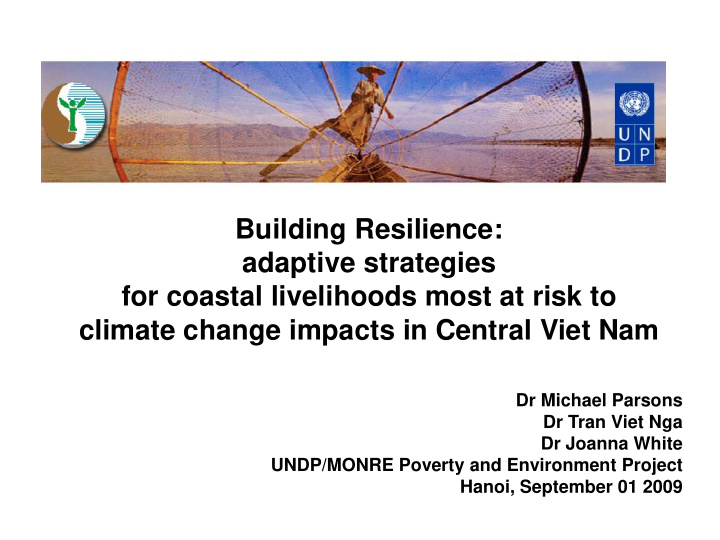



Poverty-Environment Project Building Resilience: adaptive strategies for coastal livelihoods most at risk to climate change impacts in Central Viet Nam Dr Michael Parsons Dr Tran Viet Nga Dr Joanna White UNDP/MONRE Poverty and Environment Project Hanoi, September 01 2009
Hien An 2 Village Hien Van 2 Hien Hoa 2 Village Village
Climate Change Effects • Shocks: Sudden-onset hazards eg typhoons, floods • Stress: Slow-onset hazards eg drought, salinity; gradual trends such as Increasingly drier dry seasons, wetter wet seasons, higher temperatures. and sea-level rise • Higher fluctuations (away from average, trends) and more extreme, erratic, unpredictable weather.
EROSION Coastline erosion; river bank, lagoon bank undercutting and collapse; SALINE FLOODING hillside erosion and landslides Flash floods, rainfall INTRUSION inundation floods, river Over-topping during Trend: increasing inundation floods, storm typhoons, storm surges; loss of coastline, surge over-topping; Salinization of ground river and lagoon water; banks, hillside Trend: rising sea- Sea water upstream in- soils levels,; more frequent, flows during dry intense, prolonged seasons, droughts typhoons; heavier rainfall events; but with Trend: salinity more extreme intruding further inland, Need for flexible, fluctuations increasing salinity of multiple cultivable land adaptation strategies DROUGHT FRESHENING Freshening from river Trend: more flooding and rainfall prolonged droughts, inundation SEDIMENTATION but also extreme fluctuations Typhoons, storm surges blocking Trend : higher level floods, river and estuary mouths,; prolonged inundations with Higher river sedimentation loads more extreme fluctuations widening flooding impacts Trend: increasing, more prolonged river mouth closure events
No-regret adaptive measures and issues in adaptive management • Addressing gender issues in all the below • Sector-specific measures (farming, fishing/aquaculture, combination) • Livelihood support – including building adaptive strategies for temporary migrants • Measures to minimise impacts of climate change on the livelihood resource-base • Mainstreaming climate change planning into provincial and district planning processes and assist awareness-raising • Foster more research to refine all of the above.
Adaptive measures for agriculture • Adjust adaptive strategies and extension services to ‘feminisation’ of the agricultural sector. • Support existing local adaptation measures, for example adjustment of cropping calendars, cropping patterns, switching to climate-resilient cultivars, diversified farming; inter-cropping • Reduce risk of crop failure by changes in management and farming techniques eg changes in fertilizer use and application, integrated pest management
Adaptive measures for fishing, aquaculture • Improved planning and management – eg enforcement of aquaculture waste-treatment regulations • Research to monitor and predict the movement of key fresh and saltwater fish species • Introduction of aquaculture species adapted to high temperatures and changed salinities and freshening. Assess potential impacts on indigenous varieties prior to their introduction • Promote polyculture and fish-rice rotation in relevant areas • Conduct research on salt water intrusion, fisheries and aquaculture to inform new measures • Reduce river-borne pollution
Livelihood support • Ensure access to more diverse and better targeted credit, insurance and other financial services • Broaden rural extension services mandate – marketing of climate-resilient crops • Improve access of the most at-risk to information on climate risks, adaptation measures, and market information • accessible, secure, safe storage and protection from climatic hazards • Support temporary migration as household livelihood diversification strategy
Livelihood resource-base support • Combat seawater intrusion, storm surges and sea-level rise with sea walls and green walls. • Improve water storage and management • Protect elevated land for public purpose use • Establish ‘Sister-Commune” relationships to strengthen local adaptation practices for similar social ecologies in non-contiguous areas
Mainstreaming climate change into local planning processes • Inject a spatial dimension into local planning, through mainstreaming participatory hazard maps into SEA and SEDPs, • Empower the most at risk by involving them in local-level hazard mapping and climate change planning (top-down and bottom-up). • Adapt the disaster response system to shift from a seasonal alert to year-round emergency response.
Adaptive management issues • Tailoring adaptive strategies – no ‘one-size- fits-all’ approach • Infrastructure versus living structures – how to build, how not to build (‘managed retreat’) • Use the need for new infrastructure (dykes, resettlement) as a new local livelihood opportunity • Take an integrated approach to reduce the risk of climate changes on health – plants, animals, people. • Increase remittances through pre-migration job-targeted up-skilling and vocational training
Poverty-Environment Project Thank you for your attention
Recommend
More recommend